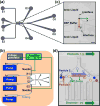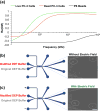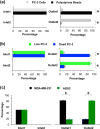Continuous On-Chip Cell Separation Based on Conductivity-Induced Dielectrophoresis with 3D Self-Assembled Ionic Liquid Electrodes
- PMID: 27409352
- PMCID: PMC5497574
- DOI: 10.1021/acs.analchem.6b02104
Continuous On-Chip Cell Separation Based on Conductivity-Induced Dielectrophoresis with 3D Self-Assembled Ionic Liquid Electrodes
Abstract
Dielectrophoresis (DEP) has been widely explored to separate cells for various applications. However, existing DEP devices are limited by the high cost associated with the use of noble metal electrodes, the need of high-voltage electric field, and/or discontinuous separation (particularly for devices without metal electrodes). We developed a DEP device with liquid electrodes, which can be used to continuously separate different types of cells or particles based on positive DEP. The device is made of polydimethylsiloxane (PDMS), and ionic liquid is used to form the liquid electrodes, which has the advantages of low cost and easy fabrication. Moreover, the conductivity gradient is utilized to achieve the DEP-based on-chip cell separation. The device was used to separate polystyrene microbeads and PC-3 human prostate cancer cells with 94.7 and 1.2% of the cells and microbeads being deflected, respectively. This device is also capable of separating live and dead PC-3 cancer cells with 89.8 and 13.2% of the live and dead cells being deflected, respectively. Moreover, MDA-MB-231 human breast cancer cells could be separated from human adipose-derived stem cells (ADSCs) using this device with high purity (81.8 and 82.5% for the ADSCs and MDA-MB-231 cells, respectively). Our data suggest the great potential of cell separation based on conductivity-induced DEP using affordable microfluidic devices with easy operation.
Figures




Similar articles
-
High-Throughput Separation, Trapping, and Manipulation of Single Cells and Particles by Combined Dielectrophoresis at a Bipolar Electrode Array.Anal Chem. 2018 Oct 2;90(19):11461-11469. doi: 10.1021/acs.analchem.8b02628. Epub 2018 Sep 19. Anal Chem. 2018. PMID: 30192521
-
Microfluidic Device for Cell Trapping with Carbon Electrodes Using Dielectrophoresis.Biomed Microdevices. 2018 Dec 10;20(4):102. doi: 10.1007/s10544-018-0350-0. Biomed Microdevices. 2018. PMID: 30536135
-
Microfluidic characterization and continuous separation of cells and particles using conducting poly(dimethyl siloxane) electrode induced alternating current-dielectrophoresis.Anal Chem. 2011 Dec 15;83(24):9579-85. doi: 10.1021/ac202137y. Epub 2011 Nov 11. Anal Chem. 2011. PMID: 22035423
-
Separation of neural stem cells by whole cell membrane capacitance using dielectrophoresis.Methods. 2018 Jan 15;133:91-103. doi: 10.1016/j.ymeth.2017.08.016. Epub 2017 Aug 31. Methods. 2018. PMID: 28864355 Free PMC article. Review.
-
Signal-Based Methods in Dielectrophoresis for Cell and Particle Separation.Biosensors (Basel). 2022 Jul 11;12(7):510. doi: 10.3390/bios12070510. Biosensors (Basel). 2022. PMID: 35884313 Free PMC article. Review.
Cited by
-
Recent Advances in Dielectrophoretic Manipulation and Separation of Microparticles and Biological Cells.Biosensors (Basel). 2024 Aug 27;14(9):417. doi: 10.3390/bios14090417. Biosensors (Basel). 2024. PMID: 39329792 Free PMC article. Review.
-
Review: Microbial analysis in dielectrophoretic microfluidic systems.Anal Chim Acta. 2017 May 8;966:11-33. doi: 10.1016/j.aca.2017.02.024. Epub 2017 Mar 6. Anal Chim Acta. 2017. PMID: 28372723 Free PMC article. Review.
-
Detection of Rare Objects by Flow Cytometry: Imaging, Cell Sorting, and Deep Learning Approaches.Int J Mol Sci. 2020 Mar 27;21(7):2323. doi: 10.3390/ijms21072323. Int J Mol Sci. 2020. PMID: 32230871 Free PMC article. Review.
-
Design and Fabrication of Microelectrodes for Dielectrophoresis and Electroosmosis in Microsystems for Bio-Applications.Micromachines (Basel). 2025 Feb 7;16(2):190. doi: 10.3390/mi16020190. Micromachines (Basel). 2025. PMID: 40047690 Free PMC article. Review.
-
Self-aligned sequential lateral field non-uniformities over channel depth for high throughput dielectrophoretic cell deflection.Lab Chip. 2021 Mar 9;21(5):835-843. doi: 10.1039/d0lc01211d. Lab Chip. 2021. PMID: 33532812 Free PMC article.
References
-
- Armstrong DW, Schneiderheinze JM, Kullman JP, He LF. Fems Microbiol Lett. 2001;194:33–37. - PubMed
-
- Cabrera CR, Yager P. Electrophoresis. 2001;22:355–362. - PubMed
-
- Fizazi K, Morat L, Chauveinc L, Prapotnich D, De Crevoisier R, Escudier B, Cathelineau X, Rozet F, Vallancien G, Sabatier L, Soria JC. Ann Oncol. 2007;18:518–521. - PubMed
-
- Girod M, Armstrong DW. Electrophoresis. 2002;23:2048–2056. - PubMed
-
- Hayes DF, Cristofanilli M, Budd GT, Ellis MJ, Stopeck A, Miller MC, Matera J, Allard WJ, Doyle GV, Terstappen LWWM. Clin Cancer Res. 2006;12:4218–4224. - PubMed
Publication types
MeSH terms
Substances
Grants and funding
LinkOut - more resources
Full Text Sources
Other Literature Sources
Miscellaneous

